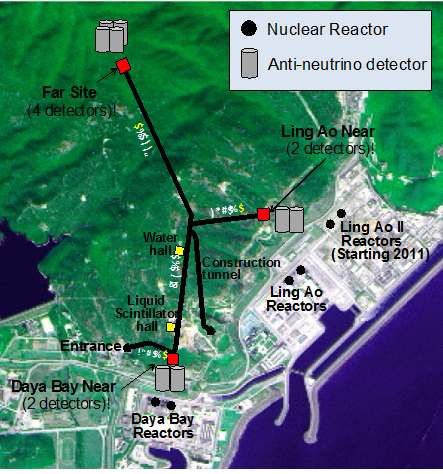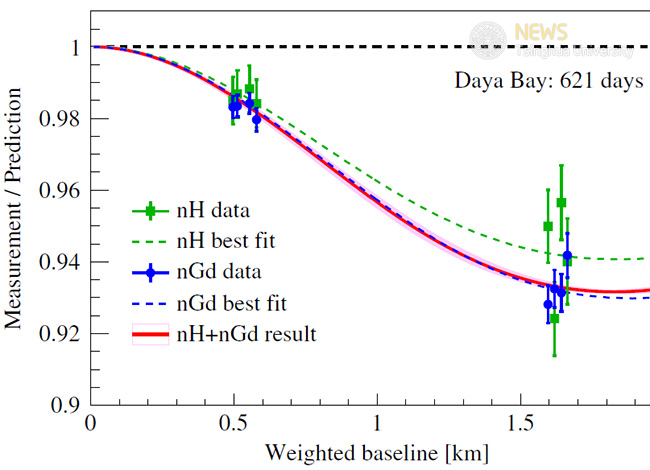Tsinghua University achieves highest precision in measuring neutrino mixing angle θ13
The international research group of the Daya Bay Reactor Neutrino Experiment has published the most precise measurement of the neutrino mixing angle θ13 to-date, which promises to greatly expand the future prospect for experimental explorations of neutrino physics. The Department of Engineering Physics at Tsinghua University made a major contribution to this effort.
The Daya Bay Reactor Neutrino Experiment is a large multinational research project with more than 200 researchers from China, the US and other countries. On April 21, the Daya Bay collaboration published its most recent study in the scientific journal Physical Review D titled “New measurement of θ13 via neutron capture on hydrogen at Daya Bay”, which presents the most precise measurement of the neutrino mixing angle θ13 to-date. This is expected to provide deeper insight into the properties of the fundamental properties of the neutrino particle, and help us understand the mechanism which gives dominance of matter over antimatter in the universe.

The configuration of the Daya Bay Reactor Neutrino Experiment.
The Daya Bay experiment is located in the Daya Bay Nuclear Power Complex in Guangdong province, China, and data recording began in August, 2011. Anti-neutrinos  produced in the nuclear reactors were detected at three experimental sites: two were placed nearer to the nuclear reactors and one farther from the reactors. A comparison of the anti-neutrinos detected at the near sites and far site made it possible to achieve precise measurement of θ13, which is largely independent of the modeling of the nuclear reactors. Eight identically-designed anti-neutrino detectors were located in the three sites, with two in each of the near site, and four in the far site. Each detector weighs 110 tons and is cylindrical, with the height and the diameter both being five meters. A reactor anti-neutrino
produced in the nuclear reactors were detected at three experimental sites: two were placed nearer to the nuclear reactors and one farther from the reactors. A comparison of the anti-neutrinos detected at the near sites and far site made it possible to achieve precise measurement of θ13, which is largely independent of the modeling of the nuclear reactors. Eight identically-designed anti-neutrino detectors were located in the three sites, with two in each of the near site, and four in the far site. Each detector weighs 110 tons and is cylindrical, with the height and the diameter both being five meters. A reactor anti-neutrino  is detected by its interaction with a proton p in the detector:
is detected by its interaction with a proton p in the detector:  +p→e++n. In this reaction, a prompt signal from the positron e+ and a delayed signal from the capture of the neutron n provide coincident signals, which makes the identification of the anti-neutrinos robust against random background interferences. The neutron was captured primarily on gadolinium (nGd) or hydrogen (nH), which produced two distinct signals, thus providing two independent data samples for analysis. The research group of Tsinghua was in charge of the measurement of the neutrino mixing angle θ13 via neutron capture on hydrogen (nH), which carries great weight in the recent publication.
+p→e++n. In this reaction, a prompt signal from the positron e+ and a delayed signal from the capture of the neutron n provide coincident signals, which makes the identification of the anti-neutrinos robust against random background interferences. The neutron was captured primarily on gadolinium (nGd) or hydrogen (nH), which produced two distinct signals, thus providing two independent data samples for analysis. The research group of Tsinghua was in charge of the measurement of the neutrino mixing angle θ13 via neutron capture on hydrogen (nH), which carries great weight in the recent publication.
In the experiments, a better understanding of the anti-neutrino detector performance was achieved and a more sophisticated analysis of the backgrounds related to the nH analysis was made. The final results attained by this technique proved to be the best in the current literature. Combined with the nGd results of Daya Bay, they provided the world’s most precise measurement of sin2 2θ13=0.082±0.004. Given that the dominant uncertainties of these results can be reduced with the increase of the amount of data collected, the results will continue to improve in the future.

Neutrino oscillation probability from the two Daya Bay measurements vs. flux-weighted baseline. The points around 0.5 km are measurements from the near sites, while those around 1.6 km are from the far site.
Tsinghua University began to participate in this experiment in 2006 as the second largest institute from mainland China, only next to Chinese Academy of Sciences. The Department of Engineering Physics leads a team consisting of researchers from Shandong University, Nankai University, Sun Yet-sen University, Chiao Tung University(Hsinchu, Taiwan), Taiwan University, to measure θ13 via neutron capture on hydrogen (nH) at Daya Bay.
This measurement technology will be used in a large forthcoming neutrino experiment hosted by China – the Jiangmen Underground Neutrino Observatory (JUNO) – whose construction started at the end of 2014 and is expected to begin commissioning in 2020. Utilizing a large spherical detector with a diameter of about 40 meters and about 20 kilo-tons of liquid scintillator, the JUNO experiment is designed primarily to determine the neutrino mass hierarchy using neutron capture on hydrogen (nH). The Department of Engineering Physics, the Department of Civil Engineering, and the Institute of Microelectronics of Tsinghua University have participated in the research of the detector and the front-end electronics.
The Department of Engineering Physics itself has also proposed an ambitious project and is hosting it at present– the Jinping Neutrino Experiment. An advisory board consisting of well-known physicists from the international scientific community supports the project and a Letter of Intent has been posted online. The Jinping Neutrino Experiment plans to install a kilo-ton-level detector in the China Jinping Underground Laboratory (CJPL), which will be operated by Tsinghua University. Because of its world-leading features in two critical aspects: 2,400 m of rock overburden and a distance greater than one thousand kilo-meters from the nuclear reactors along China’s eastern coast line, CJPL has the lowest cosmic-ray muon flux and muon-induced spallation backgrounds, and the lowest reactor neutrino background in all underground physics laboratories in the world. Thus, the Jinping Neutrino Experiment will be ideally positioned to measure solar neutrinos and geo-neutrinos, which can help further our understanding of the properties of neutrinos, while providing deep insight into the basic physics of the Sun and the Earth.
neutrino oscillation:
The oscillation (transition) between the three generations of neutrinos is a quantum mechanical phenomenon first hypothesized by Italian nuclear physicist Bruno Pontecorvo, in 1957. The 2015 Nobel Prize for Physics was awarded to Takaaki Kajita from the Super-Kamiokande Experiment and Arthur McDonald from the Sudbury Neutrino Observatory, to honor their contributions to the discovery of atmospheric neutrino and solar neutrino oscillation. As the final conclusive demonstration of three-flavor neutrino oscillation, reactor neutrino oscillation was first observed by the Daya Bay experiment in 2012. The Daya Bay collaboration was awarded the 2016 Breakthrough Prize in Fundamental Physics for its discovery and exploration of the third mode of neutrino oscillations characterized by θ13, and the most precise measurement of it is presented in this article.
(from the Department of Engineering Physics, edited by Li Huashan)
Article Link: Phys. Rev. D 93, 072011 (2016),
http://dx.doi.org/10.1103/PhysRevD.93.072011

